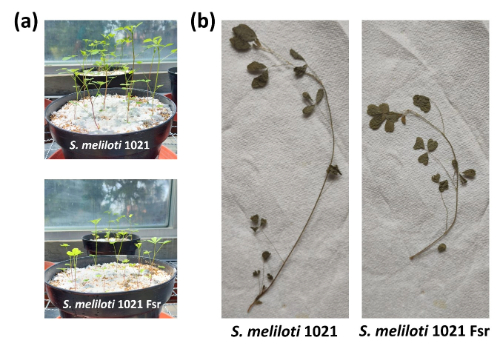A key bacterial transporter for antibiotic resistance and plant symbiosis
Posted on June 16, 2025 by Víctor M. Chávez Jacobo
Víctor M. Chávez Jacobo takes us behind the scenes of their latest publication 'The Fsr transporter of Sinorhizobium meliloti contributes to antimicrobial resistance and symbiosis with alfalfa' published in Microbiology.
Hello! I'm Victor Chavez and I had the privilege of completing a postdoctoral fellowship in Michael Dunn's lab at the Center for Genomic Science in Cuernavaca, Mexico. Through Mike´s trust and guidance, I was introduced to the fascinating world of plant—microorganism interactions, and I'd like to share my experience.
About four years ago, I had just obtained my PhD and was actively searching for postdoctoral opportunities. At the time, my experience was limited, and my primary focus was antibiotic resistance. However, I came across an opportunity in Mike's lab to study a two-component signaling system called NspS/MbaA in Sinorhizobium meliloti — a bacterium I had never heard of before, let alone studied.
We embarked on this new scientific journey and quickly encountered our first challenge: one of the project's objectives was to study S. meliloti mutants in the NspS/MbaA system and their interaction with alfalfa plants. Initially, I struggled just to get the alfalfa seeds to germinate. However, with the invaluable support of Mike and my laboratory colleagues, we soon overcame this hurdle, successfully setting up multiple experiments and characterising the system. While our findings did not directly relate to symbiosis, we observed significant changes in other processes, particularly biofilm formation and motility.
During our analyses, we found that other Sinorhizobia also conserve the NspS/MbaA system. Additionally, we identified an upstream gene – the fosmidomycin resistance (fsr) gene – that is also conserved among the bacteria we examined. This discovery quickly became the next focal point of our research.
We generated a mutation in this gene, which based on computational analysis indicated that it encoded a transporter from the major facilitator superfamily (MFS) and might be linked to resistance against the antibiotic fosmidomycin. However, our experiments revealed that the mutation does not affect resistance to fosmidomycin. Instead, the absence of this gene renders S. meliloti susceptible to other toxic compounds, including the antibiotic fosfomycin – a structural analogue of fosmidomycin – as well as moderately increases its sensitivity to hydrogen peroxide and deoxycholate. Despite their distinct mechanisms of bacterial damage, all three compounds can compromise cell integrity and contribute to bacterial death, so it is a great advantage to have a single system to protect against different types of toxic compounds.

To investigate whether the FSR protein confers resistance to toxic compounds by actively expelling them from the cell, we conducted fluorimetric assays using ethidium bromide as a substrate and an energy decoupler agent. Our findings confirmed that Fsr functions as a proton-dependent efflux pump. Additionally, we observed a decrease in biofilm formation and an increase in motility. This indicates that the FSR protein could also be involved in the export of other types of compounds, such as those related to biofilm formation.
Finally, we conducted symbiosis assays with alfalfa and found that, after 45 days, adult plants had fewer nodules per plant. Despite maintaining efficient nitrogen fixation, those inoculated with the fsr mutant were visibly smaller and exhibited a significantly lower dry weight. These experiments – and more importantly, the enriching experience of my postdoctoral stay in Mike´s laboratory – allowed us to characterize the FSR transport system. This efflux pump not only confers resistance to certain toxic compounds but also plays a role in the symbiosis between S. meliloti and alfalfa.
I'm currently conducting another postdoctoral fellowship with another research group, but I'm located just a few metres from Mike's lab, so we're still in touch. I'm currently searching for new molecules with effective antimicrobial activity against human pathogens. However, with the experience I gained during my first postdoc, I hope to soon integrate this knowledge and search for compounds that help combat phytopathogens.

